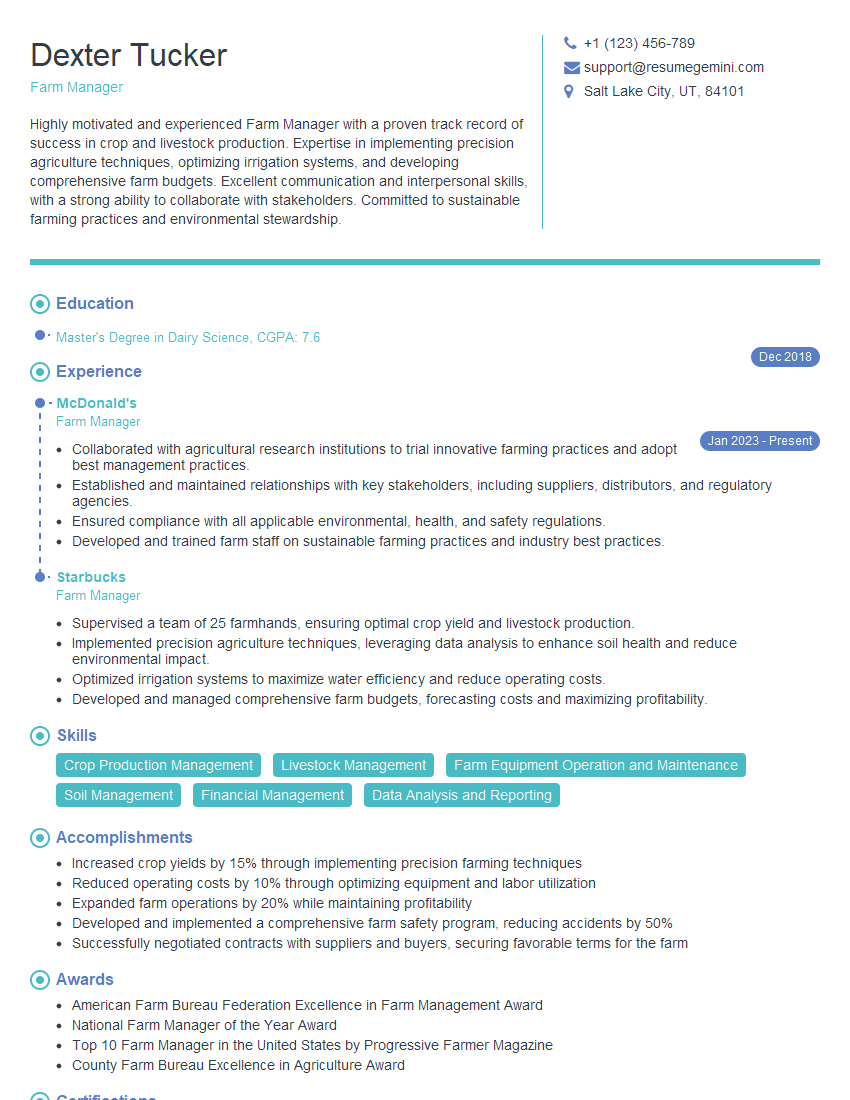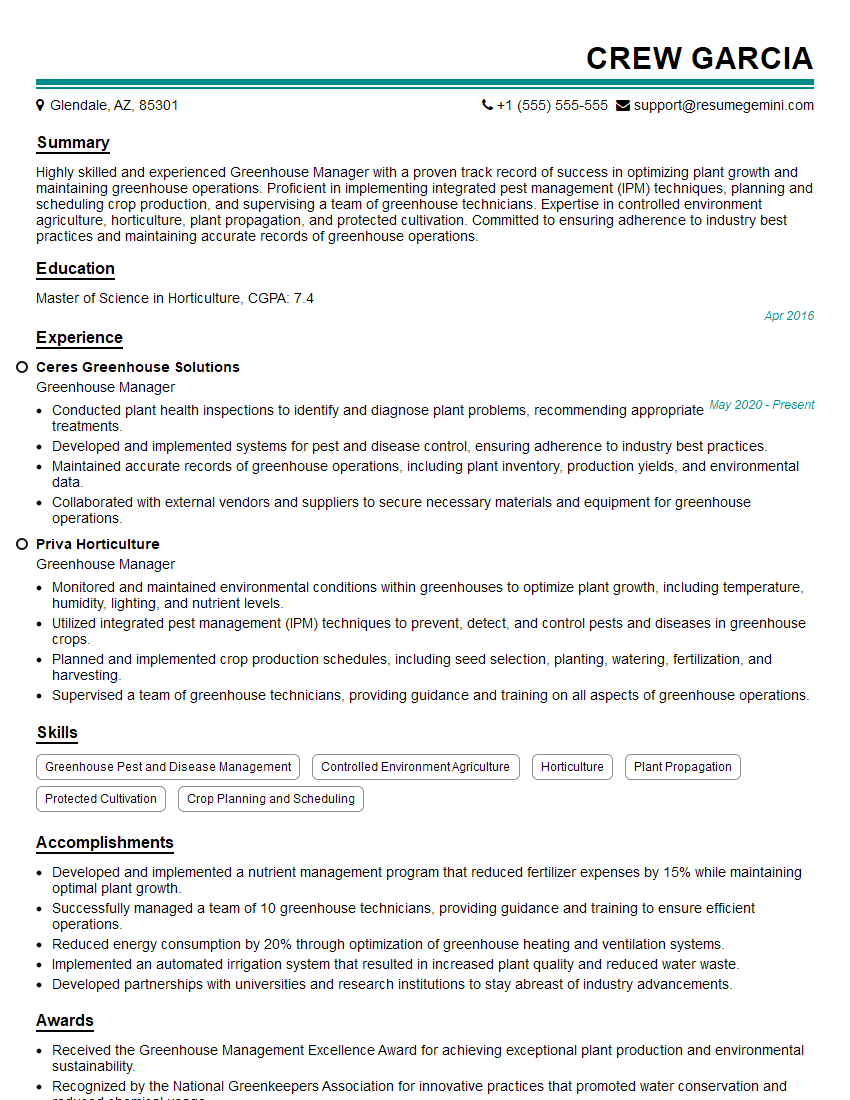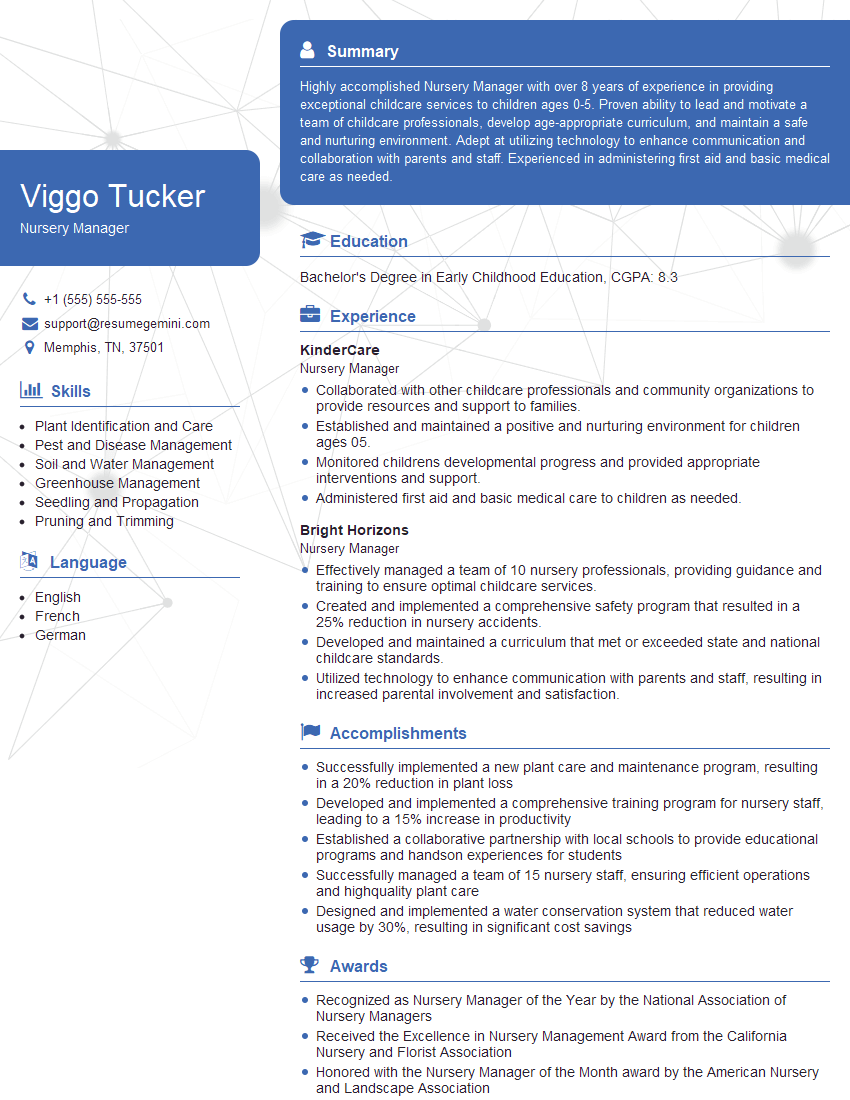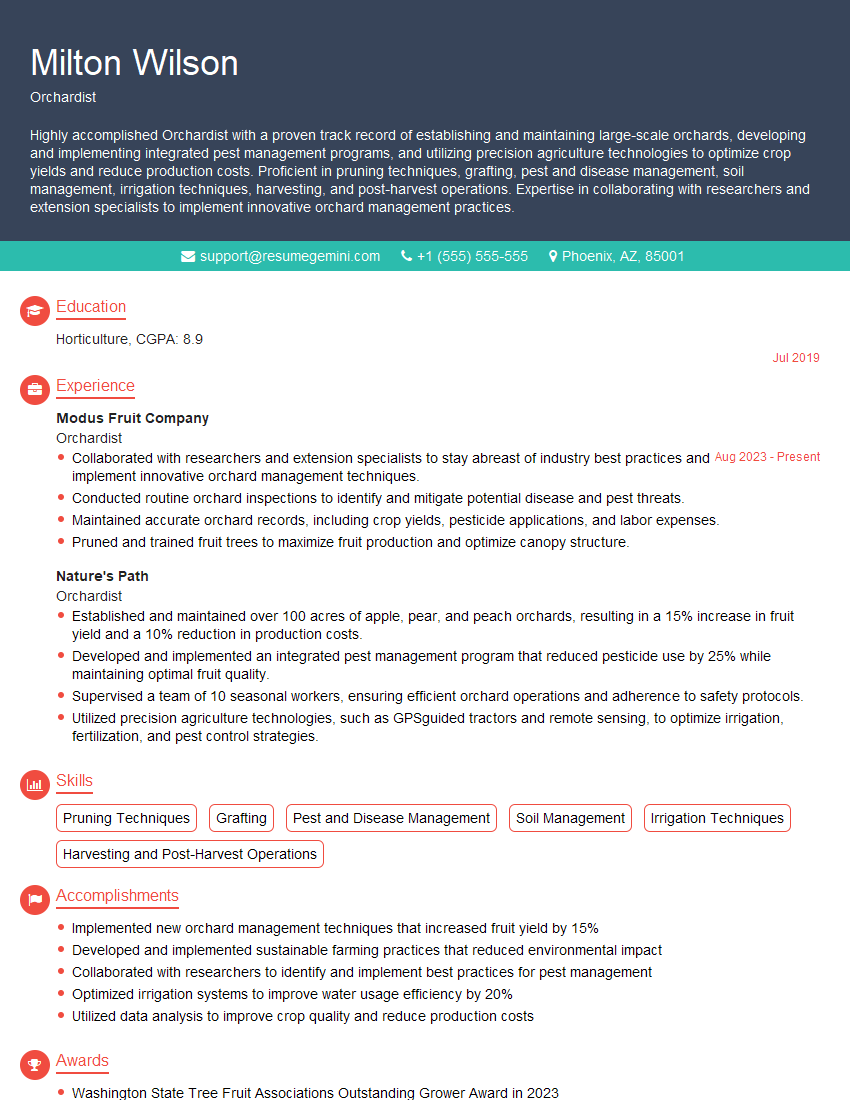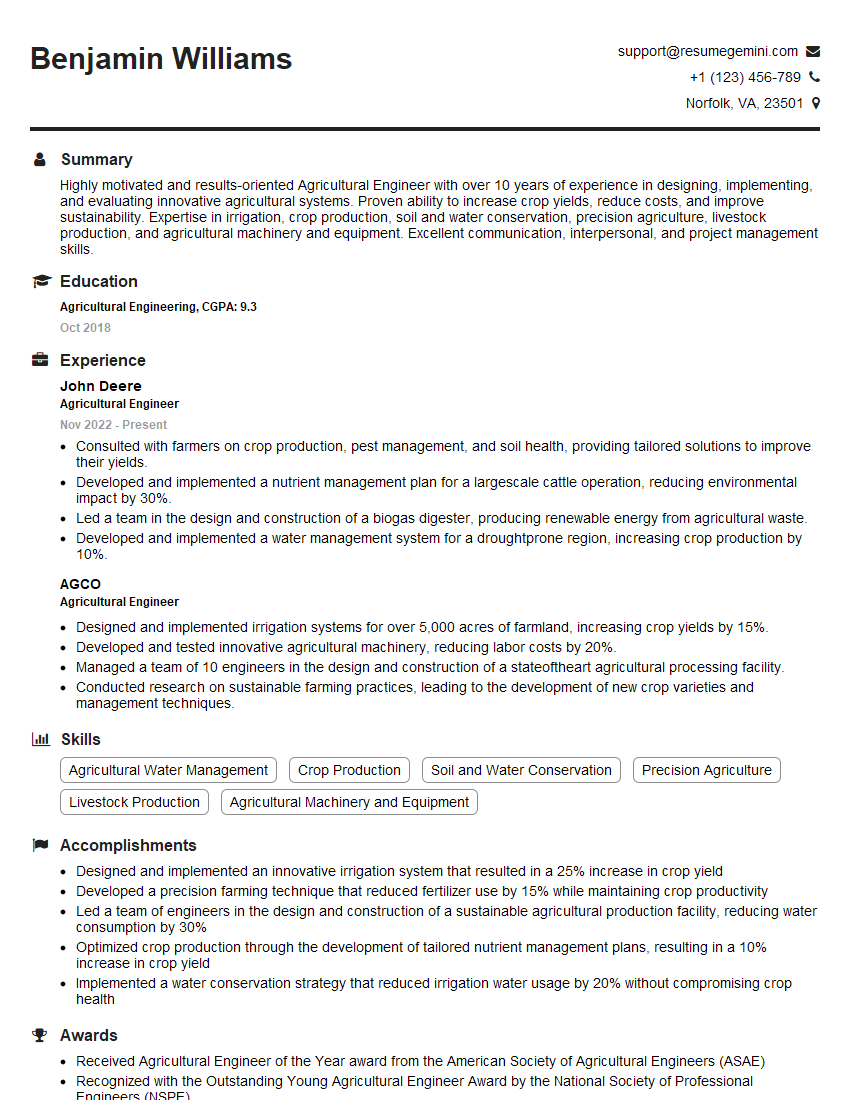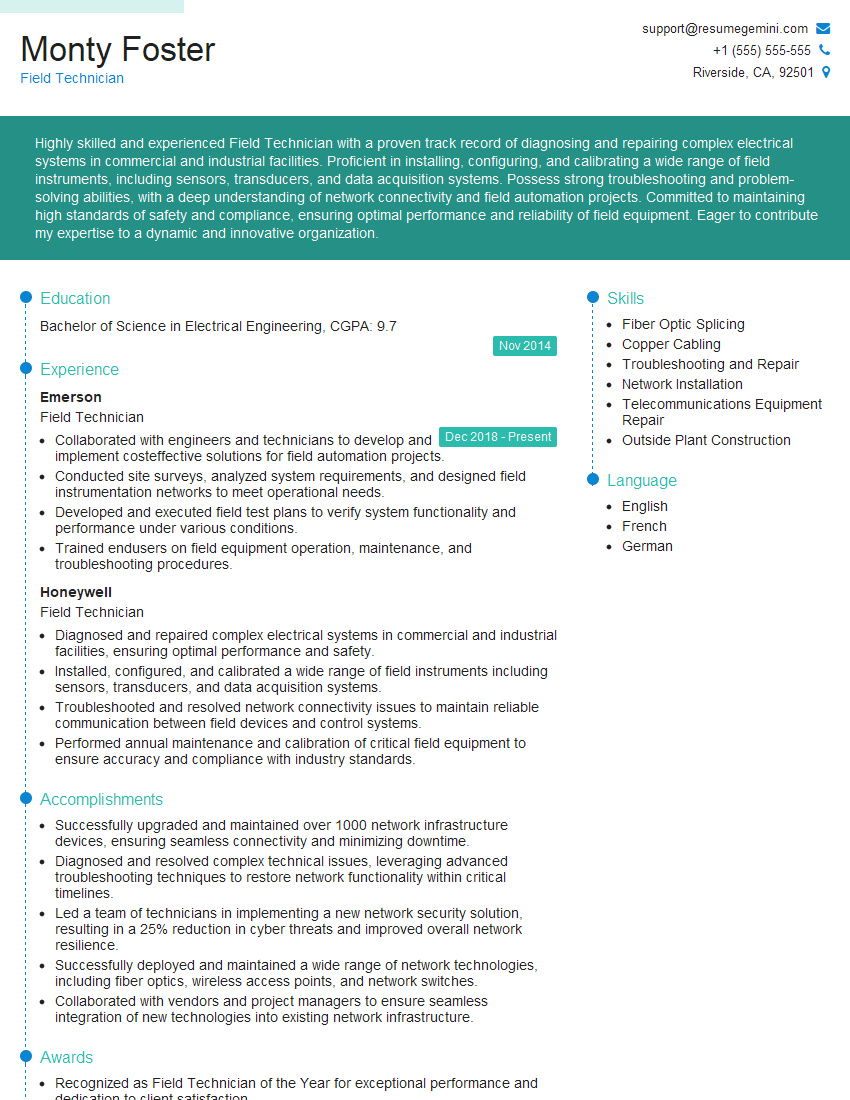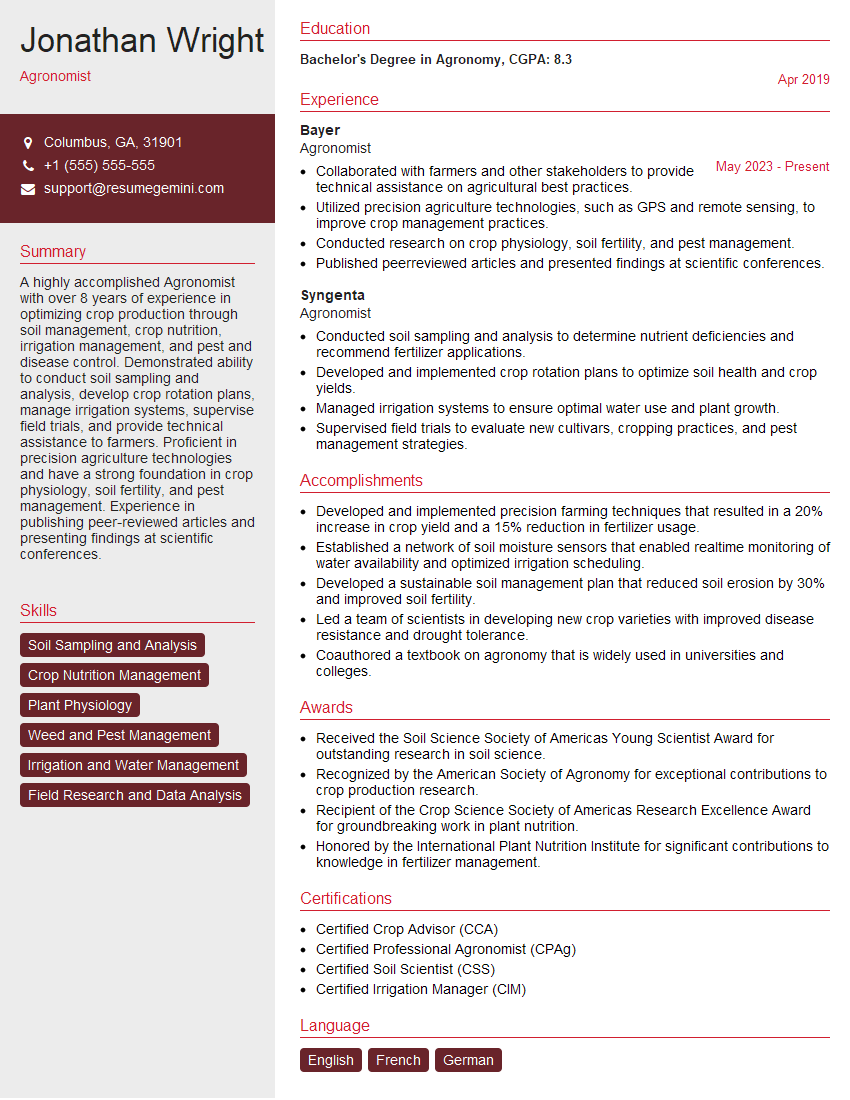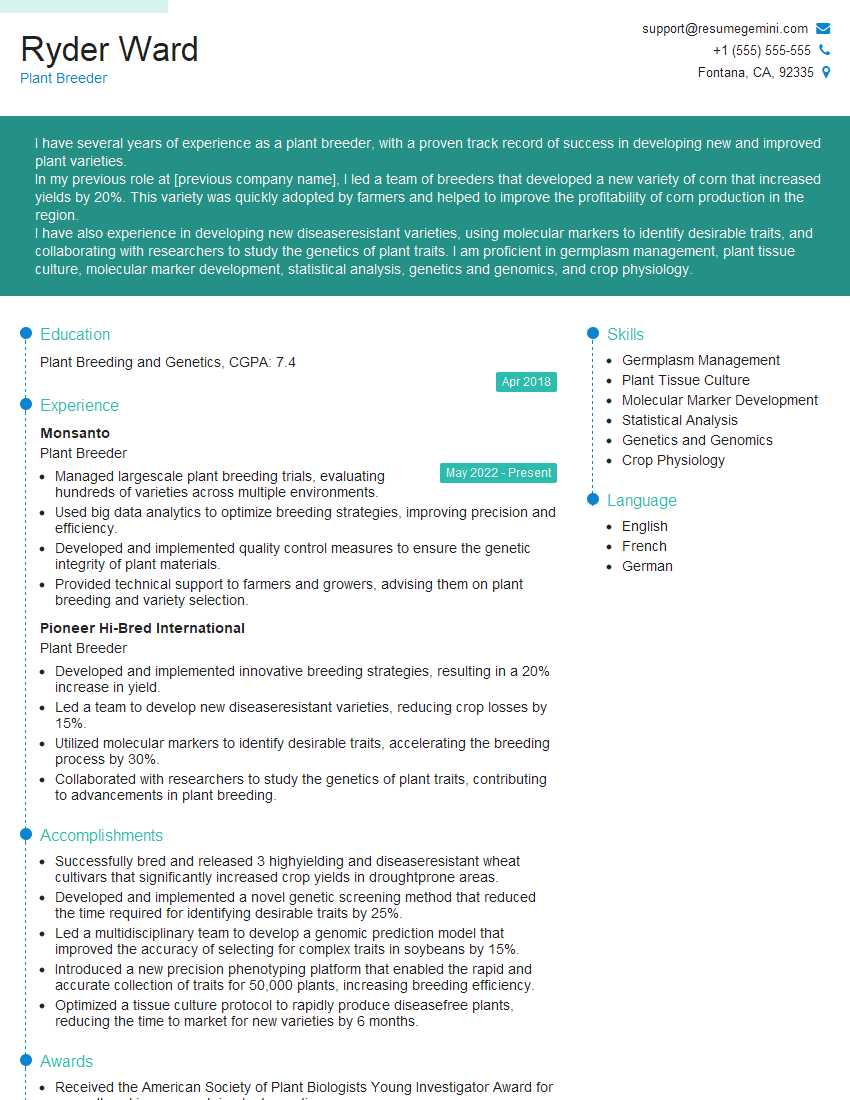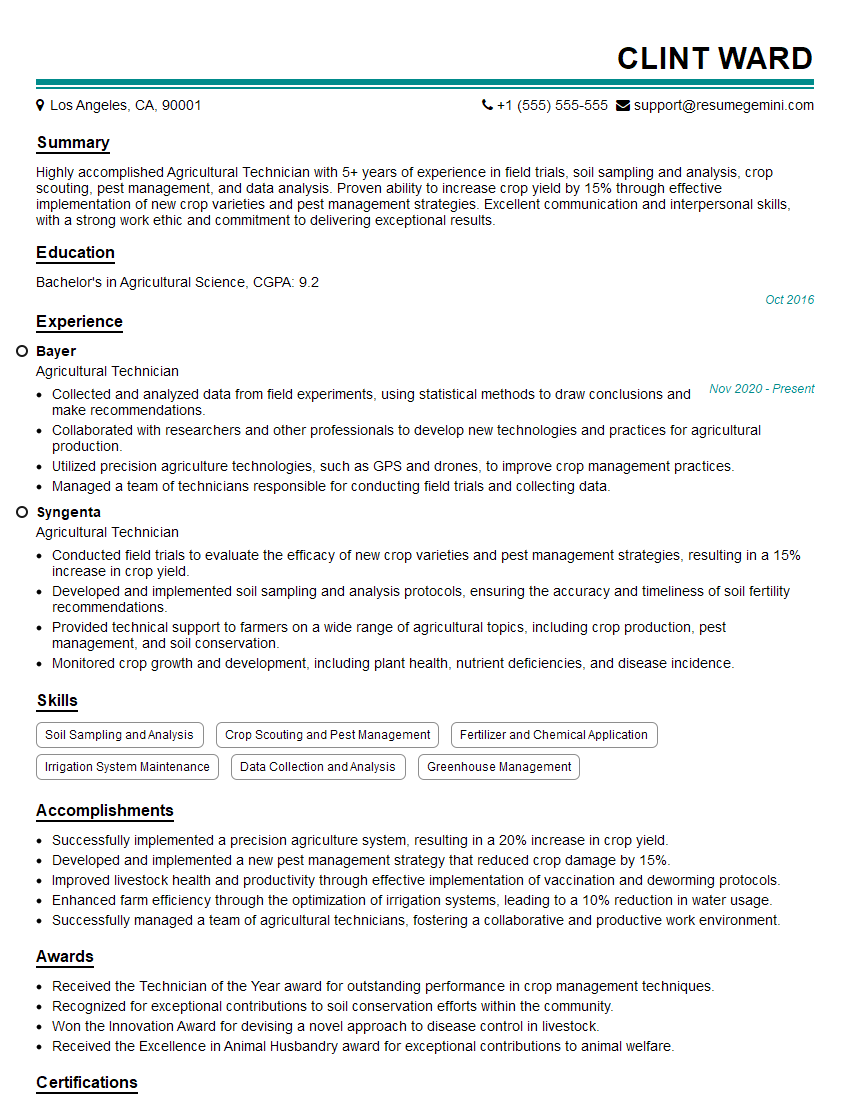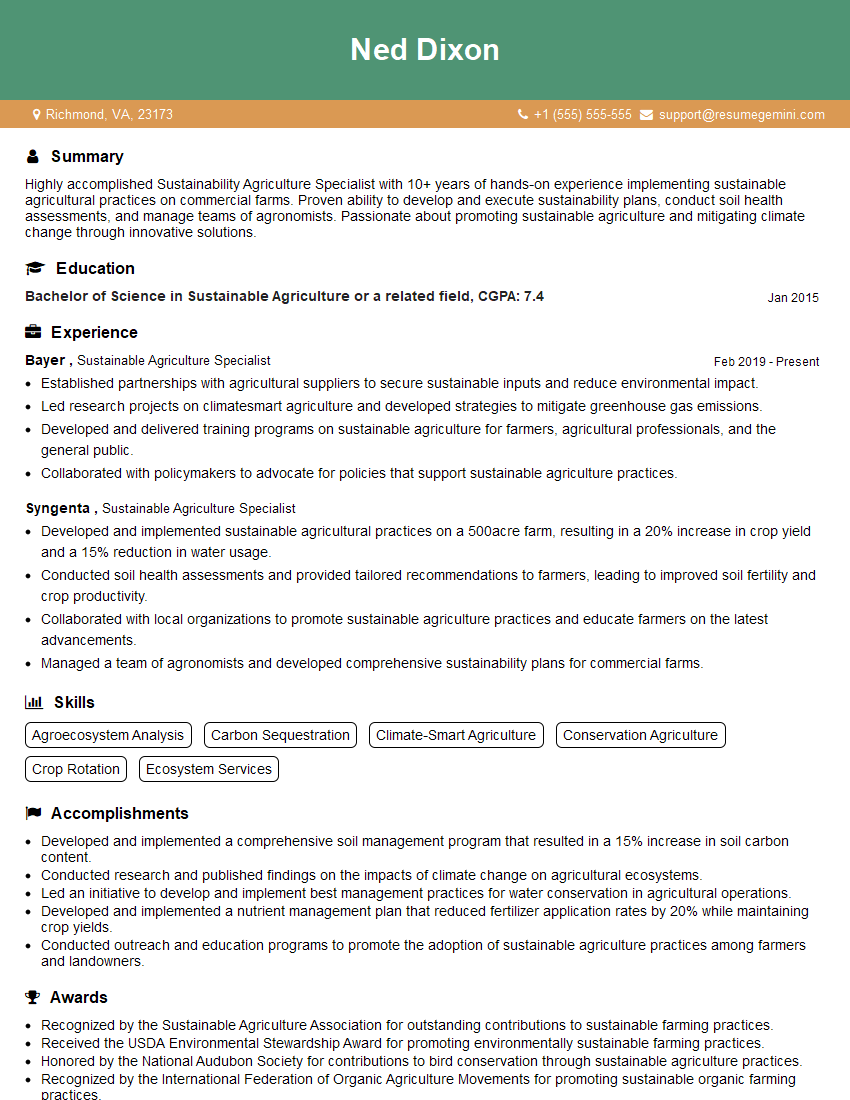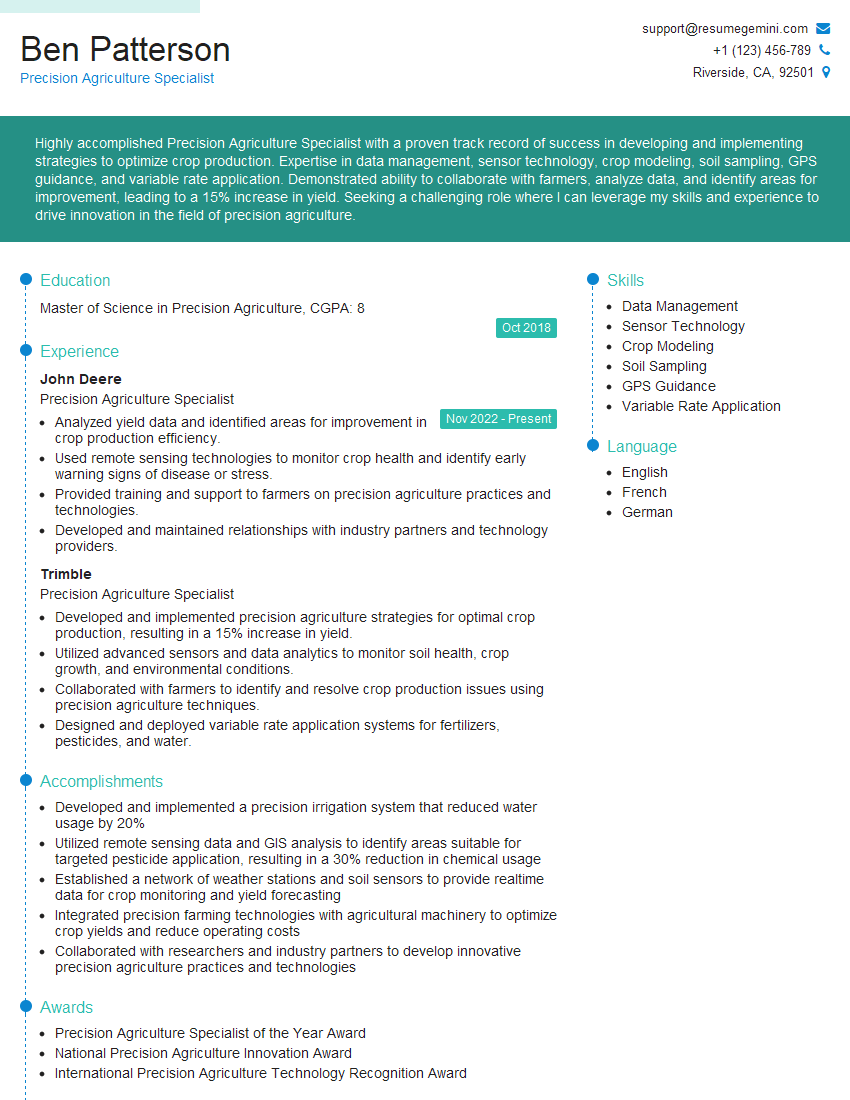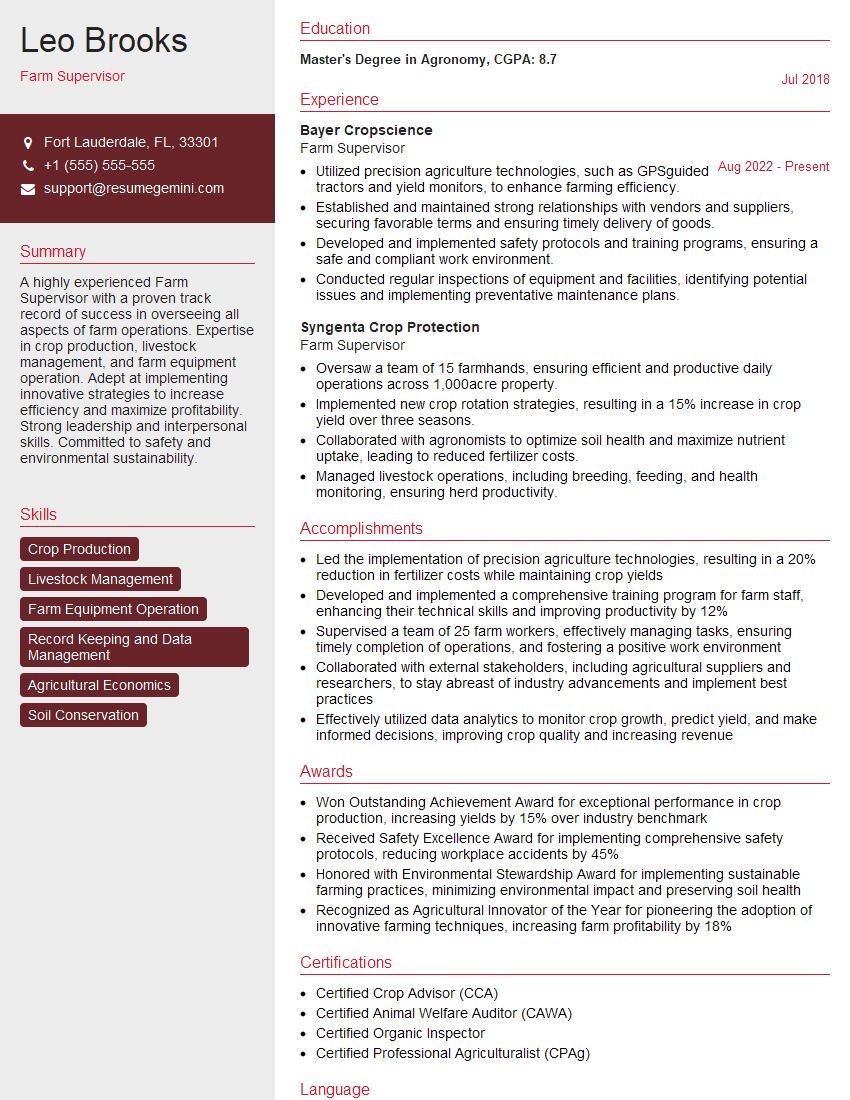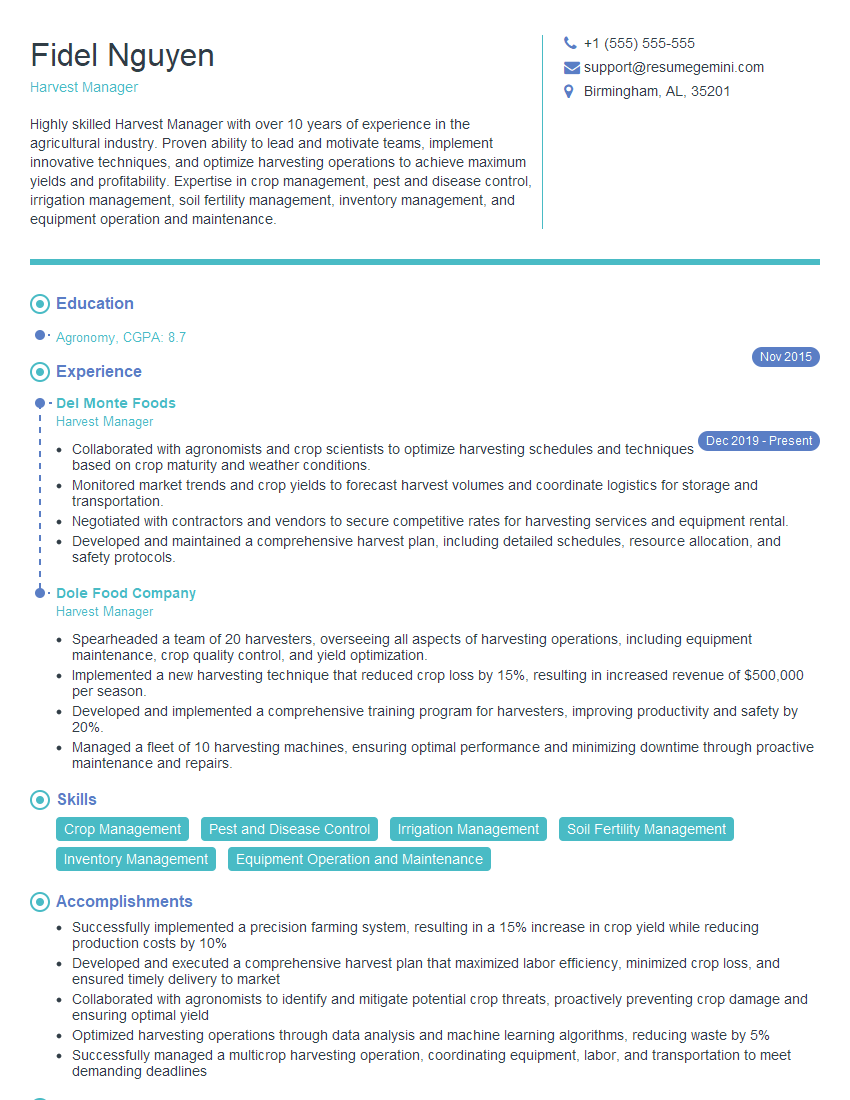Preparation is the key to success in any interview. In this post, we’ll explore crucial Planting Crops interview questions and equip you with strategies to craft impactful answers. Whether you’re a beginner or a pro, these tips will elevate your preparation.
Questions Asked in Planting Crops Interview
Q 1. Describe your experience with different planting methods (e.g., direct seeding, transplanting).
Planting methods are crucial for successful crop production. My experience encompasses both direct seeding and transplanting, each with its own advantages and disadvantages. Direct seeding involves sowing seeds directly into the prepared field. This method is cost-effective and minimizes transplant shock, but it’s less suitable for delicate seedlings or those needing specific germination conditions. I’ve successfully used direct seeding for hardy crops like wheat and corn, optimizing seed depth and spacing based on soil type and anticipated weather.
Transplanting, on the other hand, involves growing seedlings in a nursery before transferring them to the field. This gives more control over early growth and allows for better spacing and weed control. It’s ideal for crops like tomatoes and peppers that are sensitive to environmental fluctuations. In my experience, successful transplanting depends on selecting healthy seedlings, minimizing root disturbance during transplanting, and ensuring adequate watering and post-transplant care.
For example, in a recent project involving tomatoes, I utilized transplanting to maximize yield. The seedlings, grown in a protected nursery, were robust and disease-free upon transplanting, resulting in a higher yield compared to previous years where direct seeding was employed.
Q 2. Explain your knowledge of soil testing and its importance in crop planting.
Soil testing is fundamental to successful crop planting. It provides a snapshot of the soil’s composition, identifying nutrient levels, pH, and potential problems like salinity or compaction. This information is vital for making informed decisions about fertilizer application, irrigation management, and crop selection. Ignoring soil testing can lead to nutrient deficiencies, reduced yields, and environmental damage from overuse of fertilizers.
A comprehensive soil test typically involves collecting multiple soil samples from different areas of the field, mixing them thoroughly, and then sending them to a certified laboratory for analysis. The results usually indicate the levels of essential macronutrients (nitrogen, phosphorus, potassium) and micronutrients (iron, zinc, manganese, etc.). I always consider the soil test results before developing a fertilization plan. For instance, a soil test revealing low phosphorus levels would prompt me to incorporate phosphorus-rich fertilizers, ensuring optimal plant growth and maximizing yields.
In a recent project, soil testing revealed surprisingly high salinity in a section of the field, leading me to implement a soil amendment strategy which involved gypsum and strategic irrigation to lower the salinity level before planting. This prevented a significant yield reduction and saved substantial economic costs.
Q 3. How do you determine the optimal planting density for a specific crop?
Determining optimal planting density involves a careful balance. High density might lead to increased competition for resources, reducing individual plant size and overall yield, while low density might waste valuable land and result in lower total yield. The ideal planting density is crop-specific and influenced by several factors such as the crop’s growth habit, available resources (water, nutrients, sunlight), and the intended harvest method.
Several factors need to be considered when determining the optimal planting density: crop variety, row spacing, expected plant size at maturity, soil fertility, and available water resources. For instance, a large-stature corn variety would require wider spacing compared to a dwarf variety. Also, in regions with limited water, planting density might be adjusted to reduce competition for water.
I usually consult research literature and extension publications to get recommended planting densities for a specific crop and region. Then, I perform small-scale trials in different densities before finalizing the planting plan for the whole field. For example, I recently conducted a trial planting of soybeans at different densities, eventually settling on a spacing that maximized both plant size and overall yield based on the results of the trial.
Q 4. What are the key factors influencing seed germination?
Seed germination is a complex process influenced by several factors. These factors can be broadly classified into three categories: environmental, seed-related, and biotic factors.
- Environmental factors include temperature, moisture, oxygen, and light. Seeds require specific temperature ranges for optimal germination. Moisture is crucial for hydration and enzymatic activity. Sufficient oxygen is needed for respiration. Light requirements vary among different species; some seeds require light to germinate, while others are inhibited by light.
- Seed-related factors include seed quality, seed maturity, and seed dormancy. High-quality seeds with intact embryos and adequate reserves germinate better. Immature seeds might fail to germinate, and seeds with dormancy mechanisms may require specific treatments (stratification or scarification) to break dormancy.
- Biotic factors include the presence of pathogens and pests which can affect seed viability and germination.
Understanding these factors is crucial for ensuring successful germination. For example, if a seed requires light for germination, burying it too deep would prevent germination. I always ensure that my planting practices align with the specific requirements of the seed I’m planting.
Q 5. Describe your experience with irrigation systems and their management.
Irrigation is crucial for maximizing crop yields, particularly in regions with limited rainfall. My experience encompasses various irrigation systems including drip irrigation, sprinkler irrigation, and furrow irrigation. Each system has its advantages and disadvantages regarding water efficiency, cost, and suitability for different crops and terrains.
Drip irrigation delivers water directly to the plant roots, minimizing water loss through evaporation and runoff. This is highly efficient but can be expensive to install. Sprinkler irrigation is suitable for larger areas and various crops, offering good water distribution, but it’s less efficient than drip irrigation due to evaporation losses. Furrow irrigation is a simpler and less costly method where water is channeled along furrows, but it can lead to significant water waste.
Efficient irrigation management involves monitoring soil moisture levels, considering weather forecasts, and using appropriate scheduling techniques. I use soil moisture sensors to guide irrigation decisions, minimizing water usage and optimizing plant growth. In one project, using a combination of soil moisture sensors and weather data significantly reduced water consumption by 20% without compromising crop yield.
Q 6. How do you manage weed control in a crop field?
Weed control is essential for maximizing crop yields and minimizing competition for resources. My approach is an integrated weed management (IWM) strategy, combining various methods to achieve effective and sustainable weed control. IWM considers cultural practices, mechanical methods, biological control, and chemical control.
Cultural practices involve manipulating planting time, crop spacing, and tillage to suppress weed growth. Mechanical methods, such as hoeing or cultivation, physically remove weeds. Biological control involves using natural enemies of weeds. Chemical control uses herbicides to kill or suppress weeds, but it should be used judiciously to minimize environmental impact.
I always prefer an integrated approach. For example, I might use cover crops to suppress weeds before planting the main crop, followed by timely cultivation and targeted herbicide applications as needed. In a recent project, this IWM approach resulted in a 15% increase in yield compared to years relying solely on chemical control.
Q 7. Explain your understanding of crop rotation and its benefits.
Crop rotation is a crucial agricultural practice that involves planting different crops in a planned sequence on the same piece of land over several growing seasons. It offers several significant benefits, including improved soil health, reduced pest and disease pressure, and enhanced nutrient cycling.
Rotating crops helps improve soil structure by varying root systems, reducing soil compaction and erosion. Different crops have varying nutrient requirements, and crop rotation helps to balance nutrient extraction and replenishment. It also disrupts the life cycle of many soilborne pathogens and pests, thus reducing the need for pesticides.
A typical rotation might include a legume (e.g., soybeans), which fixes nitrogen in the soil, followed by a non-legume crop (e.g., corn), which benefits from the added nitrogen. This rotation enhances soil fertility and reduces reliance on synthetic nitrogen fertilizers. In my experience, a well-planned crop rotation has significantly reduced pest and disease problems and improved soil health, resulting in higher and more consistent yields.
Q 8. Describe your experience with pest and disease management in crops.
Pest and disease management is crucial for successful crop production. My approach is multifaceted, prioritizing preventative measures and integrating sustainable practices. It starts with a thorough understanding of the specific pests and diseases prevalent in the region and the crops being cultivated. This involves regular field scouting and monitoring for early signs of infestation or infection.
- Preventative Measures: This includes crop rotation to disrupt pest life cycles, using disease-resistant varieties, ensuring proper soil drainage to prevent fungal growth, and maintaining appropriate planting densities to optimize air circulation and reduce humidity.
- Integrated Pest Management (IPM): I strongly advocate for IPM, a strategy that combines various control methods to minimize reliance on chemical pesticides. This might involve biological control (introducing beneficial insects or nematodes), cultural control (adjusting planting times or tillage practices), and only using chemical pesticides as a last resort, selecting the least toxic option and applying it judiciously.
- Monitoring and Evaluation: Regular monitoring allows for early detection of problems. This includes visual inspection of plants, taking soil samples for pathogen testing, and employing traps to monitor pest populations. Based on these observations, we can adjust our management strategies, optimizing effectiveness and minimizing environmental impact.
For example, in managing potato blight (a fungal disease), I would implement preventative measures like using blight-resistant varieties, ensuring adequate spacing for air circulation, and employing a fungicide application schedule based on weather patterns and disease prediction models. If aphids become a significant problem on lettuce, I’d introduce beneficial ladybugs to control them naturally before resorting to insecticides.
Q 9. How do you assess crop health and identify potential problems?
Assessing crop health involves a combination of visual observation, data analysis, and sometimes laboratory testing. I look for tell-tale signs of stress or disease, which might include discoloration of leaves, wilting, stunted growth, unusual spots or lesions, presence of pests, or abnormal flowering patterns.
- Visual Inspection: Regular walks through the field, closely examining plants for abnormalities is paramount. I pay attention to details like leaf shape, color, and texture.
- Data Analysis: Soil testing provides crucial information about nutrient levels, pH, and the presence of harmful substances. Yield monitoring systems, using sensors or drones, can track growth rates and identify areas of stress.
- Laboratory Testing: When visual inspection and data analysis are inconclusive, I might send samples to a lab for disease identification and pathogen testing. This helps in confirming suspicions and guiding treatment strategies.
For instance, if I see yellowing leaves between the veins (interveinal chlorosis), it could indicate a micronutrient deficiency, which I’d verify through soil testing. If I notice circular lesions on leaves with a characteristic gray mold, it might suggest a fungal infection such as Botrytis, requiring further investigation.
Q 10. What are your strategies for maximizing crop yields?
Maximizing crop yields requires a holistic approach addressing all aspects of crop production. It’s not just about one thing but a combination of factors optimized together.
- Optimal Site Selection: Choosing a suitable location with appropriate soil type, sunlight exposure, and water availability is fundamental.
- Improved Genetics: Employing high-yielding and disease-resistant varieties significantly contributes to increased yields.
- Precision Agriculture: Using technology such as GPS-guided machinery, variable rate fertilization, and remote sensing allows for targeted resource application and precise management, improving resource use efficiency and yield.
- Nutrient Management: Providing the right balance of nutrients through soil testing and appropriate fertilization is essential. This includes using organic amendments to improve soil health and nutrient availability.
- Water Management: Implementing efficient irrigation systems, like drip irrigation, ensures that crops receive the optimal amount of water without waste.
- Pest and Disease Management: As previously discussed, effectively controlling pests and diseases protects crop yield from significant losses.
- Harvesting Techniques: Efficient and timely harvesting minimizes losses and maintains quality.
For example, using precision agriculture techniques, I can apply fertilizer only where needed, reducing costs and environmental impact while optimizing nutrient use for greater yield. Or employing proper irrigation techniques prevents water stress during critical growth stages and results in larger, higher-quality crops.
Q 11. Explain your experience with harvesting techniques for different crops.
Harvesting techniques vary significantly depending on the crop and its characteristics. The goal is always to maximize yield, minimize damage, and maintain quality.
- Cereals (wheat, rice, barley): Combine harvesters are typically used for efficient and large-scale harvesting. The process involves cutting, threshing (separating grain from the stalks), cleaning, and storing the grain.
- Fruits (apples, oranges, berries): Harvesting can be manual or mechanized, depending on the scale of operation and the fragility of the fruit. Manual harvesting often ensures greater care and reduces damage.
- Vegetables (tomatoes, lettuce, potatoes): Methods vary depending on the vegetable. Tomatoes might be harvested selectively by hand, while potatoes require specialized machinery for efficient digging and harvesting.
- Legumes (soybeans, peanuts): Combines are commonly used, but the harvesting process may include additional steps such as drying and shelling.
For instance, delicate strawberries would be hand-picked to avoid bruising, while potatoes, with their underground growth habit, require specialized harvesting machinery to efficiently extract them from the soil. The choice of harvesting technique always needs careful consideration of crop type, scale of operation and the cost-effectiveness involved.
Q 12. How do you ensure the quality and safety of harvested crops?
Ensuring the quality and safety of harvested crops involves meticulous attention to detail throughout the entire process, from the field to the consumer.
- Pre-harvest Practices: Proper crop management and pest/disease control contribute significantly to crop quality. Using only approved pesticides and adhering to waiting periods before harvest is critical for safety.
- Careful Harvesting: Gentle handling during harvesting prevents bruising, cuts, and other physical damage that can reduce quality and lead to spoilage.
- Cleaning and Sorting: Removing debris, damaged produce, and foreign materials ensures consistent quality and enhances shelf life. Sorting by size and quality is also essential for maintaining market standards.
- Post-Harvest Handling: Maintaining appropriate temperature, humidity, and ventilation during transport and storage helps to preserve quality and prevent spoilage.
- Food Safety Regulations: Adhering to all relevant food safety regulations and guidelines, including sanitation protocols and traceability systems, ensures safe products for consumption.
For example, rigorous cleaning of harvested produce and careful removal of damaged items greatly reduce the risk of contamination and extends shelf life. Similarly, adhering to regulations regarding pesticide use ensures safe food products that are free of harmful residues.
Q 13. What is your experience with post-harvest handling and storage?
Post-harvest handling and storage are crucial steps that significantly impact the quality and shelf life of harvested crops. My experience encompasses various aspects of this critical phase of crop production.
- Proper Cleaning and Pre-cooling: Immediately after harvest, produce should be cleaned and cooled to slow down respiration rates and reduce enzymatic activity, extending shelf life and retaining quality.
- Appropriate Storage Conditions: The optimal storage environment varies greatly depending on the type of crop. Factors like temperature, humidity, and ventilation must be carefully controlled to prevent spoilage, decay, or sprouting.
- Storage Facilities: Choosing the right storage facility—whether it’s a refrigerated warehouse, controlled atmosphere storage, or simple storage structures—is crucial for long-term preservation of crops.
- Packaging and Handling: Proper packaging protects the produce from damage during transport and storage. Careful handling throughout the process is essential to avoid bruising or other physical damage.
- Monitoring and Quality Control: Regular checks to monitor temperature, humidity, and the condition of the stored crops are vital for early detection of any issues and prompt corrective action.
For instance, storing apples in a controlled atmosphere (reduced oxygen, increased carbon dioxide) can significantly extend their storage life, preventing spoilage and preserving quality for several months. Proper ventilation during grain storage helps to prevent fungal growth and maintain optimal moisture content.
Q 14. Describe your knowledge of different types of fertilizers and their application.
Fertilizers are essential for providing crops with the necessary nutrients for optimal growth and yield. My knowledge covers various types, their application methods, and their impact on soil and crop health.
- Inorganic Fertilizers (Mineral Fertilizers): These are manufactured and contain specific ratios of NPK (nitrogen, phosphorus, and potassium) and other micronutrients. Examples include urea (high in nitrogen), diammonium phosphate (DAP), and muriate of potash (potassium chloride).
- Organic Fertilizers: Derived from natural sources, these fertilizers provide nutrients in a slow-release form, improving soil structure and fertility. Examples include compost, manure, and bone meal.
- Biofertilizers: These contain microorganisms that help plants access nutrients more efficiently. Examples include nitrogen-fixing bacteria and mycorrhizal fungi.
- Fertilizer Application Methods: Methods include broadcasting (spreading evenly across the field), banding (applying in rows alongside seeds or seedlings), side-dressing (applying during the growing season), foliar application (spraying directly onto leaves), and fertigation (applying through irrigation systems).
The choice of fertilizer and application method depends on several factors, including the crop’s nutritional needs, soil type, and environmental conditions. For example, a nitrogen-deficient soil might require the application of urea as a quick-release nitrogen source, while organic matter amendment might improve soil structure and overall fertility in the long term. The use of fertigation ensures efficient nutrient uptake by plants and minimizes nutrient loss.
Q 15. Explain your understanding of sustainable agriculture practices.
Sustainable agriculture practices are farming methods that aim to meet the current food and fiber needs without compromising the ability of future generations to meet their own needs. It’s about balancing environmental, social, and economic considerations. This means focusing on long-term soil health, minimizing environmental impact, and ensuring the economic viability of the farm.
- Soil Health: Implementing practices like no-till farming, cover cropping, and crop rotation to improve soil structure, fertility, and water retention. For example, using cover crops like clover helps to fix nitrogen in the soil, reducing the need for synthetic fertilizers.
- Water Conservation: Employing efficient irrigation techniques like drip irrigation or rainwater harvesting to minimize water waste. This is especially crucial in arid regions.
- Pest and Disease Management: Implementing Integrated Pest Management (IPM) strategies, which prioritize biological controls and other methods to minimize reliance on synthetic pesticides.
- Biodiversity: Maintaining crop diversity to prevent pest and disease outbreaks and support healthy ecosystems. Rotating crops helps break pest cycles and prevent soil nutrient depletion.
- Economic Viability: Sustainable farming must be profitable. This involves efficient resource management and potentially exploring diversified income streams such as agritourism or direct marketing.
Career Expert Tips:
- Ace those interviews! Prepare effectively by reviewing the Top 50 Most Common Interview Questions on ResumeGemini.
- Navigate your job search with confidence! Explore a wide range of Career Tips on ResumeGemini. Learn about common challenges and recommendations to overcome them.
- Craft the perfect resume! Master the Art of Resume Writing with ResumeGemini’s guide. Showcase your unique qualifications and achievements effectively.
- Don’t miss out on holiday savings! Build your dream resume with ResumeGemini’s ATS optimized templates.
Q 16. How do you monitor and adjust planting schedules based on weather conditions?
Monitoring and adjusting planting schedules based on weather conditions is critical for successful crop production. I rely on a combination of historical weather data, current forecasts, and real-time monitoring. This involves using weather stations, satellite imagery, and predictive models.
- Historical Data: Analyzing past weather patterns, including temperature, rainfall, and frost dates, helps establish a baseline and anticipate potential risks.
- Current Forecasts: Utilizing weather forecasts from reliable sources allows me to adjust planting dates to avoid extreme conditions, such as prolonged periods of drought or frost.
- Real-time Monitoring: Employing weather stations on the farm provides precise information about current conditions. This enables timely adjustments to irrigation schedules or other management practices.
- Predictive Models: Sophisticated models can simulate future weather conditions, providing valuable insights for planting decisions. For example, a model might predict a heat wave, prompting a shift to a heat-tolerant crop variety or adjusting planting time to avoid the hottest period.
For instance, during a particularly dry spring, I might delay planting until sufficient rainfall is predicted to ensure adequate soil moisture for germination and seedling establishment. Conversely, if an early frost is anticipated, I’d accelerate planting to allow the crop to reach a more mature, frost-resistant stage.
Q 17. What is your experience with precision agriculture technologies?
I have extensive experience with precision agriculture technologies, leveraging them to enhance efficiency and optimize resource use. This includes using GPS-guided machinery, variable rate technology, and data analytics for informed decision-making.
- GPS-guided machinery: Using GPS-guided tractors and other equipment ensures accurate planting, spraying, and harvesting, minimizing overlaps and reducing input waste. This results in significant cost savings and enhanced efficiency.
- Variable Rate Technology (VRT): VRT enables the application of inputs, such as fertilizer and pesticides, at varying rates across the field based on site-specific needs. Soil sensors and mapping tools identify areas requiring higher or lower inputs, optimizing resource use and minimizing environmental impact. For instance, an area with lower nitrogen levels will receive a higher dose of nitrogen fertilizer.
- Data Analytics: Using sensors, yield monitors, and remote sensing data, I gather substantial information about crop growth, soil conditions, and other critical factors. Analyzing this data reveals patterns and insights that guide informed decision-making.
For example, using yield monitors in the harvester provides detailed maps showing yield variations across the field. This information guides decisions about fertilizer application and soil management practices in subsequent years.
Q 18. Describe your knowledge of different soil types and their suitability for various crops.
Understanding soil types is fundamental to successful crop production. Different crops thrive in different soil conditions. My knowledge encompasses various soil classifications based on texture (sand, silt, clay), structure, drainage, pH, and nutrient content.
- Sandy Soils: Well-drained, but low in water and nutrient retention. Suitable for crops with low water requirements and good drainage tolerance, such as potatoes or certain vegetables.
- Clay Soils: Poorly drained, high in water and nutrient retention. Prone to compaction, which can hinder root growth. Suitable for crops that tolerate wet conditions, though drainage improvements might be needed.
- Silty Soils: Moderate water retention and drainage. Generally fertile and suitable for a wider range of crops.
- Loamy Soils: A mix of sand, silt, and clay; considered ideal for most crops due to their good drainage, aeration, and nutrient-holding capacity.
Before planting, I always conduct a soil test to determine its pH, nutrient levels (nitrogen, phosphorus, potassium), and organic matter content. This information guides decisions about soil amendments, fertilizer application, and the selection of suitable crops.
Q 19. How do you manage labor and resources effectively during planting and harvesting?
Effective labor and resource management is vital for efficient and profitable farming. I utilize various strategies to ensure optimal use of both.
- Mechanization: Employing appropriate machinery for planting, spraying, and harvesting significantly reduces labor requirements and increases efficiency. This includes using GPS-guided machinery for precise operations.
- Scheduling and Planning: Developing detailed planting and harvesting schedules that consider weather conditions, labor availability, and equipment capacity optimizes resource allocation.
- Training and Skill Development: Investing in training and skill development for farm workers improves efficiency and ensures consistent quality of work. A well-trained team performs tasks more efficiently and effectively.
- Resource Allocation: Optimizing the use of seeds, fertilizers, pesticides, water, and other resources minimizes waste and lowers costs.
- Outsourcing: If necessary, outsourcing some tasks, such as harvesting or specialized operations, may be cost-effective.
For example, during peak planting seasons, I might bring in temporary labor to supplement the permanent workforce, ensuring timely planting and minimizing delays.
Q 20. What are your strategies for dealing with crop failures or unexpected challenges?
Crop failures and unexpected challenges are inherent risks in agriculture. My strategies involve proactive risk management, contingency planning, and rapid adaptation.
- Diversification: Planting a variety of crops reduces the overall risk. If one crop fails, others might still yield a reasonable harvest.
- Crop Insurance: Securing appropriate crop insurance provides financial protection against losses due to unforeseen events such as drought, frost, or pest outbreaks.
- Pest and Disease Management: Employing Integrated Pest Management (IPM) strategies, including scouting, monitoring, and proactive treatment, minimizes the impact of pests and diseases.
- Soil Health Management: Maintaining healthy soil through practices like no-till farming and cover cropping enhances the resilience of crops to various stresses.
- Adaptation and Learning: Analyzing the causes of failures and adjusting future management practices to mitigate similar issues in the future. Keeping up-to-date with current research and best practices is important for making well-informed decisions.
For instance, if a drought significantly reduces the yield of a specific crop, I’ll analyze the reasons behind it and consider switching to drought-tolerant varieties or employing alternative irrigation techniques in subsequent years.
Q 21. Explain your experience with using GPS and GIS technologies in agriculture.
GPS and GIS technologies play a crucial role in my agricultural operations, enhancing precision and efficiency.
- GPS-guided machinery: Using GPS-enabled tractors and other equipment ensures accurate field operations, minimizing overlaps and reducing input waste. This leads to better utilization of resources and improved yields.
- Precision Mapping: Using GIS software to create precise maps of fields, showing variations in soil properties, topography, and other factors. This allows for site-specific management practices.
- Yield Monitoring: Integrating yield data with GIS allows for the creation of yield maps, revealing areas with high and low yields. This information guides future decisions on fertilizer application and other practices.
- Field Boundary Management: Precisely defining field boundaries with GPS coordinates streamlines record-keeping and ensures accurate input application, preventing overlaps or gaps in treatments.
For example, using GIS, I can overlay soil maps with yield maps, identifying areas where specific soil limitations may be affecting crop productivity. This allows me to target improvements such as drainage or fertilization to those specific areas.
Q 22. How do you ensure compliance with agricultural regulations and safety standards?
Ensuring compliance with agricultural regulations and safety standards is paramount for sustainable and ethical crop production. This involves a multi-faceted approach encompassing thorough knowledge of relevant laws, meticulous record-keeping, and proactive implementation of safety protocols.
- Understanding Regulations: I stay updated on all local, state, and federal regulations related to pesticide use, water quality, soil conservation, and worker safety. This includes familiarizing myself with the specific requirements for the crops I cultivate and the region where I operate. For example, understanding the permitted application rates of specific pesticides is crucial to avoid exceeding legal limits and harming the environment.
- Record Keeping: Meticulous record-keeping is essential. I maintain detailed records of all inputs used, including fertilizers, pesticides, and irrigation practices. This documentation is critical for traceability, ensuring compliance, and assisting with potential audits. My records include dates, quantities, application methods, and any observed effects.
- Safety Protocols: Worker safety is my top priority. This means providing proper training on the safe handling of equipment and chemicals, ensuring access to appropriate personal protective equipment (PPE), and implementing emergency response plans. Regular safety inspections and drills are conducted to maintain a safe working environment.
- Third-Party Audits: I actively participate in third-party audits to independently verify compliance with regulations and standards. This demonstrates a commitment to transparency and accountability.
By adhering to these practices, I minimize risks associated with non-compliance, protect the environment, and ensure the safety of my workforce.
Q 23. Describe your experience with data analysis and its application in crop management.
Data analysis plays a vital role in optimizing crop management, allowing for evidence-based decision-making. My experience encompasses leveraging various data sources and analytical techniques to improve yields, resource efficiency, and overall profitability.
- Data Sources: I utilize data from various sources, including weather stations, soil sensors, yield monitors on harvesting equipment, and remote sensing technologies (like drones and satellite imagery). These provide insights into soil conditions, plant health, weather patterns, and yield variations across the field.
- Analytical Techniques: I employ various statistical and machine learning techniques. For instance, I use regression analysis to predict yields based on historical data and current conditions. I also apply spatial analysis to identify areas within a field that require targeted interventions.
Example: Using a GIS system to map soil nutrient levels and optimize fertilizer application. - Applications in Crop Management: Data analysis directly informs my decisions related to planting density, irrigation scheduling, fertilizer application, and pest control. By identifying areas of stress or underperformance, I can implement precise interventions, thereby maximizing resource use and minimizing waste. For example, if data analysis reveals low nitrogen levels in a specific section of the field, I can target fertilizer application to that area only.
Ultimately, data-driven decision making leads to improved efficiency, reduced costs, and enhanced sustainability in my crop production practices.
Q 24. What are your strategies for minimizing environmental impact in crop production?
Minimizing environmental impact is a crucial aspect of responsible crop production. My strategies focus on reducing resource consumption, protecting biodiversity, and mitigating pollution.
- Conservation Tillage: I implement conservation tillage techniques such as no-till farming to reduce soil erosion and improve soil health. This minimizes disruption to the soil ecosystem and reduces the need for chemical inputs.
- Precision Irrigation: I utilize precision irrigation systems to optimize water usage, reducing water waste and conserving this precious resource. Sensors and data analysis guide irrigation scheduling, ensuring crops receive the precise amount of water they need.
- Integrated Pest Management (IPM): I employ IPM strategies that prioritize preventative measures and minimize the use of synthetic pesticides. This involves using biological controls, crop rotation, and other sustainable methods to manage pests and diseases.
- Cover Cropping: I utilize cover crops to improve soil health, prevent erosion, and suppress weeds, minimizing the need for chemical herbicides. Cover crops also enhance biodiversity and improve soil structure.
- Renewable Energy: Where possible, I incorporate renewable energy sources such as solar power to reduce reliance on fossil fuels and lower carbon emissions.
By integrating these environmentally friendly practices, I contribute to the sustainability of my operation and help to protect our natural resources.
Q 25. Describe your understanding of the economic aspects of crop production.
Understanding the economic aspects of crop production is crucial for profitability and long-term sustainability. It involves careful cost analysis, market forecasting, and efficient resource allocation.
- Cost Analysis: I meticulously track all costs associated with production, including seeds, fertilizers, pesticides, labor, equipment, and land rent. This detailed accounting allows for informed decision-making regarding pricing strategies and identifying areas for cost reduction.
- Market Forecasting: I stay abreast of market trends and forecast prices for my crops to optimize planting decisions and pricing strategies. This involves monitoring commodity markets and understanding factors that influence supply and demand.
- Risk Management: I understand and mitigate risks associated with price volatility, weather events, and pest outbreaks. This might include strategies like diversification of crops, crop insurance, and hedging in commodity markets.
- Resource Allocation: I allocate resources efficiently to maximize profits. This includes optimizing inputs such as fertilizers and pesticides based on data analysis and ensuring efficient utilization of labor and equipment.
By strategically managing the economic aspects of my operation, I ensure the financial viability of my farm and can make informed decisions that support its long-term sustainability.
Q 26. Explain your experience with crop insurance and risk management.
Crop insurance and risk management are integral to protecting against financial losses due to unforeseen circumstances. My experience encompasses understanding different insurance policies and integrating risk mitigation strategies into my operational planning.
- Insurance Policy Selection: I carefully evaluate various crop insurance options, considering coverage levels, premiums, and deductible amounts to find the best fit for my specific needs and risk tolerance. This includes understanding the specific perils covered by each policy (e.g., drought, hail, frost).
- Risk Assessment: I regularly assess the potential risks to my crops, including weather patterns, pest infestations, and market fluctuations. This helps determine the appropriate level of insurance coverage and informs other risk mitigation strategies.
- Risk Mitigation Strategies: In addition to insurance, I implement various risk mitigation strategies, such as crop diversification, choosing disease-resistant varieties, and employing conservation tillage practices to reduce the impact of adverse events.
- Claims Management: I am familiar with the claims process and documentation requirements to ensure a smooth and efficient process in the event of a covered loss. This includes accurate record keeping throughout the growing season.
By implementing a comprehensive risk management strategy that includes appropriate insurance coverage, I protect my farm’s financial stability and ensure its long-term viability.
Q 27. How do you stay updated on the latest advancements in crop production technology?
Staying updated on advancements in crop production technology is crucial for maintaining a competitive edge and maximizing efficiency and sustainability. I utilize multiple methods to stay informed.
- Professional Organizations: I actively participate in professional organizations, attending conferences and workshops to learn about the latest research and innovations. This includes networking with other growers and experts in the field.
- Scientific Journals and Publications: I regularly read scientific journals and industry publications to stay informed about breakthroughs in crop genetics, pest management, and precision agriculture.
- Online Resources and Webinars: I utilize various online resources, including university extension programs and industry websites, to access information on new technologies and best practices. Webinars and online courses provide a convenient way to learn from experts.
- Industry Trade Shows and Exhibitions: I attend industry trade shows and exhibitions to see firsthand the latest equipment and technologies, and to connect with vendors and other professionals.
By continuously seeking knowledge and incorporating the latest advancements, I ensure my farming practices are at the forefront of innovation.
Q 28. Describe a time you had to solve a significant problem related to crop planting or management.
During a particularly dry summer, my corn crop experienced significant stress due to insufficient rainfall. Yields were projected to be significantly below average, impacting my profitability and jeopardizing the farm’s financial health.
- Problem Identification: Early monitoring using soil moisture sensors revealed a severe water deficit in several areas of the field. This was confirmed by visual inspection of the crop, showing signs of wilting and stunted growth.
- Solution Development: I immediately implemented a multi-pronged approach. First, I carefully assessed the extent of the drought damage. I then deployed a supplemental irrigation system, targeting areas most affected by the water shortage. Secondly, I evaluated the cost-effectiveness of deploying additional irrigation resources against purchasing crop insurance. I opted for supplemental irrigation given the advanced stage of the crop and its projected recovery under irrigation.
- Implementation and Monitoring: The supplemental irrigation system was implemented quickly, with careful monitoring of soil moisture levels and crop response. This involved regularly assessing the crop’s condition and adjusting the irrigation schedule as needed.
- Outcome: Although yields were slightly below the initial projections, the supplemental irrigation significantly mitigated the impact of the drought. We avoided a complete crop failure, minimizing losses and preventing a potential financial crisis for the farm.
This experience underscored the importance of proactive monitoring, integrated risk management, and the ability to adapt quickly to challenging circumstances. The ability to leverage technology (soil moisture sensors) and swiftly shift tactics to ensure crop survival was invaluable.
Key Topics to Learn for Planting Crops Interview
- Soil Science Fundamentals: Understanding soil composition, pH levels, nutrient content, and drainage is crucial for successful planting. This includes knowledge of soil testing methods and amendment techniques.
- Crop Selection and Variety: Learn about different crop types suitable for various climates and soil conditions. Consider factors like yield potential, pest resistance, and market demand when choosing varieties.
- Planting Techniques: Mastering different planting methods (e.g., direct seeding, transplanting) and their applications based on crop type and environmental factors is essential. Understanding seed spacing, depth, and timing is key.
- Crop Management Practices: Familiarize yourself with irrigation techniques, fertilization strategies (organic and inorganic), weed and pest control methods (integrated pest management), and harvest procedures. This includes understanding the environmental impact of each practice.
- Crop Rotation and Intercropping: Understand the benefits of crop rotation for soil health, pest control, and yield improvement. Learn about different intercropping strategies and their applications.
- Sustainable Agricultural Practices: Demonstrate knowledge of environmentally friendly farming methods, including water conservation, reduced pesticide use, and soil health improvement techniques. This is increasingly important in modern agriculture.
- Problem-Solving and Troubleshooting: Be prepared to discuss common challenges faced in planting crops, such as dealing with pests, diseases, adverse weather conditions, and nutrient deficiencies. Showcase your ability to diagnose problems and implement effective solutions.
Next Steps
Mastering the art of planting crops opens doors to a rewarding career in agriculture, offering opportunities for innovation and contributing to global food security. To significantly improve your job prospects, create an ATS-friendly resume that effectively highlights your skills and experience. We highly recommend using ResumeGemini, a trusted resource, to build a professional and impactful resume. Examples of resumes tailored to the Planting Crops field are available to guide you. Let ResumeGemini help you present your qualifications in the best possible light.
Explore more articles
Users Rating of Our Blogs
Share Your Experience
We value your feedback! Please rate our content and share your thoughts (optional).
What Readers Say About Our Blog
Hello,
We found issues with your domain’s email setup that may be sending your messages to spam or blocking them completely. InboxShield Mini shows you how to fix it in minutes — no tech skills required.
Scan your domain now for details: https://inboxshield-mini.com/
— Adam @ InboxShield Mini
Reply STOP to unsubscribe
Hi, are you owner of interviewgemini.com? What if I told you I could help you find extra time in your schedule, reconnect with leads you didn’t even realize you missed, and bring in more “I want to work with you” conversations, without increasing your ad spend or hiring a full-time employee?
All with a flexible, budget-friendly service that could easily pay for itself. Sounds good?
Would it be nice to jump on a quick 10-minute call so I can show you exactly how we make this work?
Best,
Hapei
Marketing Director
Hey, I know you’re the owner of interviewgemini.com. I’ll be quick.
Fundraising for your business is tough and time-consuming. We make it easier by guaranteeing two private investor meetings each month, for six months. No demos, no pitch events – just direct introductions to active investors matched to your startup.
If youR17;re raising, this could help you build real momentum. Want me to send more info?
Hi, I represent an SEO company that specialises in getting you AI citations and higher rankings on Google. I’d like to offer you a 100% free SEO audit for your website. Would you be interested?
Hi, I represent an SEO company that specialises in getting you AI citations and higher rankings on Google. I’d like to offer you a 100% free SEO audit for your website. Would you be interested?
good
